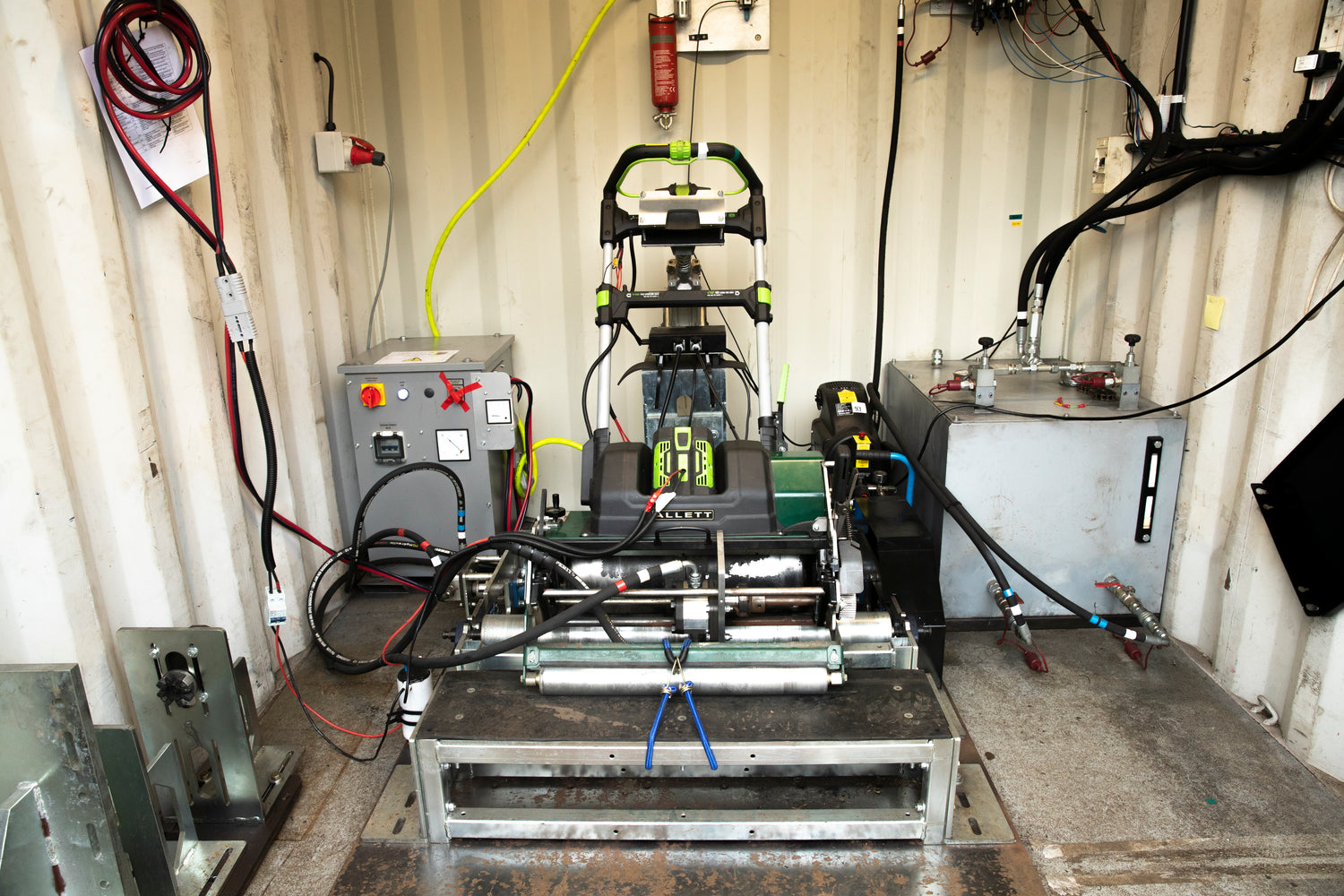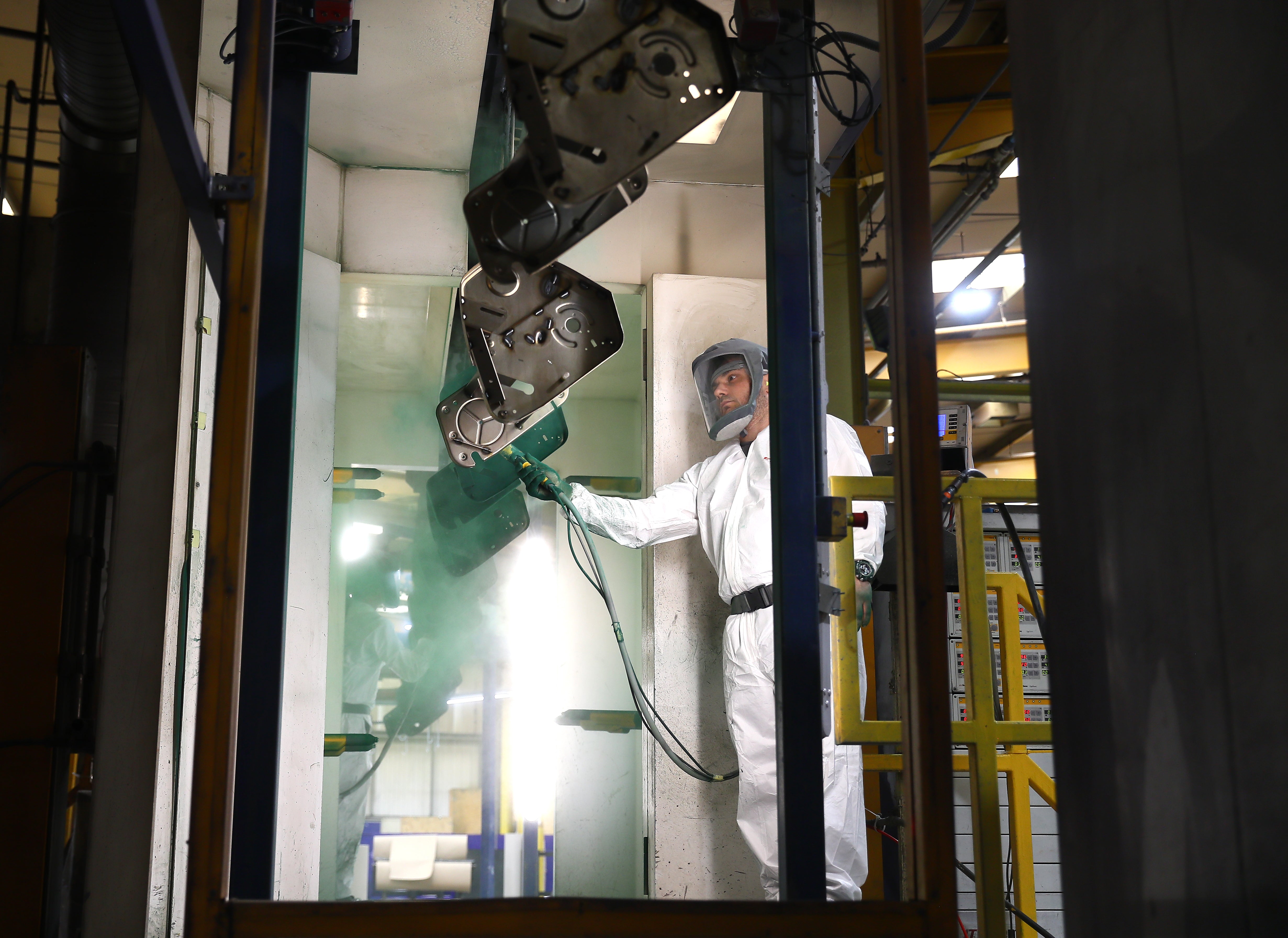We've come to the end of our testing and now we can start making Allett Stirling's on our production line at Allett. So what's involved in testing? There are three stages to testing including safety testing, reliability testing and performance testing.
Safety testing
Here at Allett we always design to the most applicable standard and safety testing involves flash testing which involves checking the insulation is equivalent to the voltage we're putting through it. We also check the guarding so you don't get any pinch points. We guard all the belts and the cylinder as much as possible. We undertake a programme of noise and vibration testing just to make sure the user's not at any risk. The benefit of battery powered mowers going forward is that there is much less hand arm vibration and lower noise levels which obviously has a great benefit to the operators health long term. Our professional gardeners using mowers all day long are at great risk of vibration white finger. Hand Arm Vibration Syndrome (HAVS) caused by exposure to vibration at work is preventable, but once the damage is done it is permanent. The Stirling has low levels of vibration.
Symptoms
- Tingling and numbness in the fingers (which can cause sleep disturbance)
- Not being able to feel things with your fingers
- Loss of strength in your hands (you may be less able to pick up or hold heavy objects)
- In the cold and wet, the tips of your fingers going white then red and become painful on recovery (vibration white finger)

Noise testing allows us to keep noise levels to a minimum (90dB). Our professional customers will be using this mower in environments such as schools and colleges as well as residential areas so low noise levels are important. With the mower being quieter other noises such as the cylinder can be heard more easily. We undertake noise testing so we can insulate areas of high noise. Our new SURE-BLADE cutting cylinder for the Stirling is great as it has little contact and is much quieter.
Reliability Testing
So next is reliability testing and the Allett rig plays a significant role in that at Allett. In this process we're looking at how well components such as belts, bearings , gears, motors and rollers and any wearing parts last through the product life cycle. So how do we check for reliability? We keep an eye on temperatures on the mower as it's on the test rig. We need to ensure parts aren't overheating. We remove parts intermittently and measure and inspect for how much wear has occurred. We normally test for a minimum of seven years life and we achieved this in four weeks of testing. It's quite an aggressive program and we run the rig 24 hours a day 7 days a week. We are happy that the mower can survive a minimum of 4 solid weeks on this aggressive rig it can survive anything!
So how do we monitor the machine when it's on the test rig? We've had a camera installed into the rig this year which lets us keep an eye on what's going on on the rig even over the Xmas period. The data logger has been invaluable to us this year and has been a massive advancement for us. We can look at current, volts, temperature all remotely from anywhere in the world really. We recently sent a test Stirling over to Australia so we could keep an eye on the mowers performance in hot conditions and different grass types- something we can't test in the middle of winter in England. The data logger beams the information straight to a phone so we can look at what's going on and even over Christmas and New Year we could see what was happening and if we had to come in to take action or not.

Here we are testing the height of cut gauge on the Stirling. You can see a short video of James in action here
Performance Testing
The other stage of testing is performance testing this is invaluable to us here at Allett to help us improve and develop our products .It's really good to get the voice of the customer in the product and listen to what they like and dislike about the product. First we take the mower ourselves and use it in different scenarios and we also sent it home with our Managing Director Austin who has a great sized lawn so he can use it on his lawn and get his honest feedback. We were able to use the data from Austin's lawn for the rig.
Mark Marshall is a pro gardener from Macclesfield he's had a Stirling for some time now so he's been lifting it in and out of vans trying all the different cartridges and giving us really good feedback on all the features . It's important to get reliability testing in in real life. We wanted Mark to be using all the cartridges and be swapping them in and out regularly to get his feedback.
Because here at Allett we sell worldwide it's really important for us to get a good handle on the different grass varieties and climates around the world especially their effect on our mower and how well we perform so we sent mowers to Australia, Germany and the USA. We sent a machine to Australia where temperatures can reach up to 40 degrees ambient. We have been able to mimic this in the test container where we can raise the temperature to 40 degrees by shutting the doors and putting some heaters on. We can check the data on our data logger so we can see what's going on.
So how does the test rig work? It's an old shipping container we repurposed to make a little test cell . We have a battery that sits in the rig that is connected to a transformer. We're using this set up because if we're running 24/7 we can't really run off a battery because we'd have to be in the rig all the time to swap them over. So what are we testing on the rig? We're tipping the mower back every 30 seconds to test the structural integrity of the chassis and the handlebars. This mimics turning the mower round at the end of a lawn. Next we load through the cartridge where we use a hydraulic motor and restrict the output so it puts a varying load on the cylinder motor. After that we've got it on a little rolling road which uses an old Buffalo roller. We've purposely made it run eccentrically so it puts a vibration into the machine that replicates running over an undulating lawn. To vary the load on the rear roller we again run that through another hydraulic motor and then we can vary the load on on that as well. The important part is the data logger which is capturing all the data temperature sensors and current from the mowers as it's running and we can check that live and save it for future reference and analysis.
Early in 2019 we designed this test rig at Allett. We designed it so it was modular so we can test any size of mower we've tested Uplift 86E's, C34E's and the new Allett Stirlings in here. Each year we improve the test rig to make it better.

So why do we test mowers?
- Our customers demand a world-class British-made product. Here at Allett we have a strong reputation for long-lasting mowers. We still supply spares for the first mowers we designed and developed in 1965. We need to ensure the mower is going to endure several years of hard usage from both professional groundsmen/gardeners and homeowners.
- We want to prove new features that customers have thought of on our products. The Stirling is designed from customer feedback received over the years. Our customers wanted a quicker cartridge change that didn't involve taking 6 screws out so we were able to meet this demand and then get our customers to test the new feature. There have been several other changes also which have come from customer feedback via social media etc and constant communication with our customers eg the height of cut dial where we now show the height in mm .
- We use customers of different profiles to test machines such as pro gardeners like Mark Marshall, groundsmen like Gary Barwell at Edgbaston and homeowners this lets us get feedback from all working conditions. Gary Barwell would be using the mower at different heights of cut for example on cricket wickets to Mark Marshall who would be cutting most lawns between 20-30mm. We send machines all around the world to test them in different climates and grass types. This enables us to ensure the mower is suitable for all grass types as well as different climates and humidities.
So now we've completed the testing on the Stirling we've given it the green light for launch and you can hope to see it in your garden soon.
You can find our TESTING VIDEO here





Leave a comment
This site is protected by hCaptcha and the hCaptcha Privacy Policy and Terms of Service apply.